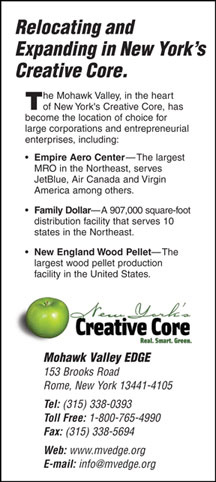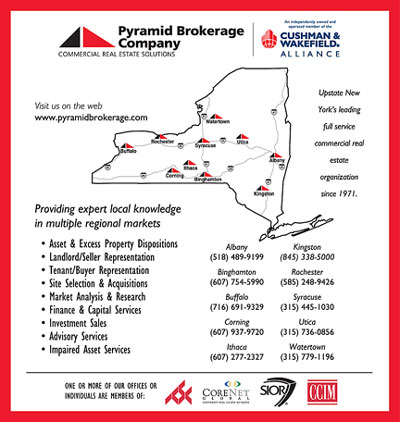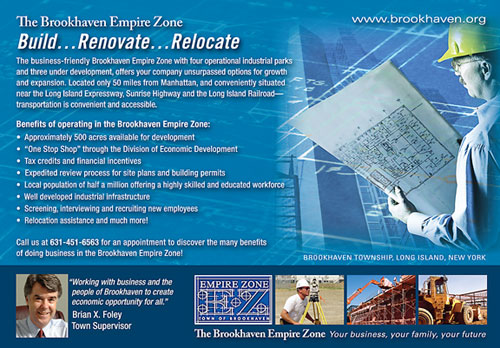ost people who have observed the economy of the northeast United States are familiar with the decline of manufacturing jobs in New York State. Of course, New York State had more manufacturing jobs to lose than most other states, being the leader in industrial employment beginning with the Industrial Revolution in the mid-1800s. By the early 1900s, more than 1 million New Yorkers worked in manufacturing when the population of New York State was 7,268,894. By World War II the population of NYS had doubled and so did manufacturing employment. There were ups and downs in the 1960s and 1970s, but the steady decline in the 1980s became a massive exodus in the early 1990s. Between 1989 and 1994, New York State lost an average of 42,820 industrial jobs per year. Despite this, the state ranks seventh in the nation in manufacturing, with over 550,000 employees. Manufacturing accounts for 10.5% of all jobs in New York State and contributes $61 billion annually to New York State’s GDP. It is especially important to the upstate New York economy. The state has a diverse manufacturing base, but principal industries are printing and publishing, industrial machinery and equipment, electronic equipment and instruments. Recently there has been growth in pharmaceuticals, food processing, energy, imaging and nano-electronics.
For example, employment in the pharmaceutical industry in New York has grown 22 percent over the last 25 years. Recently, Wyeth Pharmaceuticals reached a new contract for the roughly 900 union workers employed at the company’s Pearl River plant in Rockland County. The Pearl River plant is a major research and development center and a manufacturer of vaccines and health products, including Centrum vitamins. It is Rockland County’s largest private employer with approximately 3,200 workers.
In food processing, international firms have found fertile ground in upstate New York. Greek yogurt manufacturer FAGE Dairy has built a $70 million yogurt manufacturing plant in the Fulton County City of Johnstown, N.Y. The plant will employ up to 100 workers. Barilla Pasta of Parma Italy has constructed a new $75 million pasta manufacturing facility in the Livingston County Village of Avon, just south of Rochester. The plant is Barilla’s second in the U.S. and will supply pasta to the northeastern part of the country. This accounts for 50 percent of Barilla’s U.S. sales. Beech-Nut, now owned by Swiss food group Hero, AG will invest more than $124 million to construct a new 650,000 square-foot baby-food processing and packaging plant in the Montgomery County, town of Florida near Amsterdam, N.Y. They will also relocate their corporate headquarters from St. Louis, Mo, to the new facility. The new production facility will replace an aging, flood-damaged plant in the nearby Village of Canajoharie, N.Y., and a nearby plant in Fort Plain, N.Y. Beech-Nut will retain its current 356 production jobs in the area, with the headquarters relocation leading to the creation of 135 new jobs.
all jobs in New York State and contributes
$61 billion annually to New York State’s GDP.
General Electric is driving growth on energy and imaging. GE Power Generation is investing $40 million to renovate a 203,000-square-foot building in Schenectady, N.Y. that dates back to the early 1900s. This will create 500 jobs at GE’s Schenectady campus, with the new employees providing engineering support to multiple divisions throughout GE. They are expected to earn an average wage of $75,000 a year. In addition to this, ground was broken last November for a new GE Healthcare Digital X-Ray Manufacturing Facility at Rensselaer Technology Park. The facility will produce state-of-the-art digital X-ray mammography machines based on technology?that was developed at the GE Global Research Center in?Niskayuna. The 150,000-square-foot facility will feature 60,000 square feet of clean room space and have an annual payroll of approximately $10 million. GE will spend $65 million to construct the building, $40 million on new equipment and $20 million in other investments over the next 10 years. One hundred (100) new jobs will be created and the business is expected to grow at double-digit rates. Fifty (50) scientists from?GE Global Research will transfer to the new plant when it’s completed sometime in early 2009.
Of course, the hot news in upstate New York is in nano-electronics in the Capital region, or what has come to be known as “Tech Valley.” The establishment of Sematech as an “anchor partner” at the University at Albany’s College of Nanoscale Science and Engineering and International Sematech headquarters and operations will add 450 high-paying jobs over the next three years and contribute to the attraction of semiconductor manufacturing, in addition to that which is operated by IBM in the Hudson Valley. Advanced Micro Devices Inc. is moving steadily forward on a proposed $3.2 billion computer chip fabrication plant to be built at the Luther Forest Technology Campus in Saratoga County. They recently received the “regionally significant project” designation from the state’s Empire State Development Corp., making the company eligible for?Empire Zone tax credits.
The plant will create 1,200 permanent jobs and 2,000 construction jobs. The spin-off could provide as many as 3,600 additional permanent new jobs to the area and the potential to attract additional semiconductor fabs in the future.
Why is all of the above happening in New York State? The chief reasons are; location and proximity to markets, workforce, raw materials, shovel-ready sites and incentives, but not in that particular order for each different industry. Other less known reasons are some favorable tax exemptions that are exclusively designed to benefit manufacturing. They are:
- Manufacturers are exempt from fuels and power used in production and R&D.
- New York State and local taxing jurisdictions do not tax personal property, whether tangible or intangible. Many other states do.
- Businesses that make new investments in real estate for production and/or machinery & equipment, qualify for an Investment Tax Credit of up to 5 percent of their eligible investment. Unused credits can be carried forward for 15 years.
- Investments in research and development facilities are eligible for a 9 percent corporate tax credit. Additional credits are available to encourage the creation and expansion of emerging technology businesses, including a three-year job creation credit of $1,000 per employee and a capital credit for investments in emerging technologies.
- A workers’ compensation reform bill was enacted in 2007 which imposes limits on the duration of benefits in “permanent partial disability” cases, which had driven New York’s workers’ comp costs to a level that was uncompetitive with many states. The reforms enacted are reducing premiums by an average of 20 percent.
- New York State offers exemptions of sales tax for purchases of production machinery and equipment, research and development property. Other exemptions are available through local Industrial Development Agencies (IDAs).
- To encourage development, expansion, and improvement of industrial property many local taxing jurisdictions have adopted the Section 485b, 10-year property tax abatement. This partially offsets increased assessments due to improvements to industrial and commercial property.
New York State’s Empire Zone Program also provides powerful benefits to manufacturers. Some of them are:
- The investment tax credit is increased to 10 percent. New to NYS businesses may elect to receive a refund of certain credits. Unused credits can be carried forward indefinitely and new businesses are eligible for a 50-percent refund of unused credits.
- An additional employment incentive credit equal to 30 percent of the investment tax credit is available for each of the three years after the investment tax credit is claimed if employment is increased when the investment is made. Unused credits can be carried forward indefinitely and new businesses are eligible for a 50-percent refund of unused credits (personal income tax only).
- Companies hiring full-time or full-time equivalent employees in an EZ can receive a wage tax credit for up to five consecutive years. Credits are $1,500 per employee; for employees in special targeted groups the amount is raised to $3,000 per employee per year. In investment zones, this credit is increased by $500 for workers with wages over $40,000. Unused credits can be carried forward indefinitely and new businesses (those that have been taxable for five years or less) are eligible for a 50-percent refund of unused credits.
- A refund of the State portion of the sales tax is available for the purchase of building materials used in the construction or renovation of industrial or commercial property located in a zone.
reducing premiums by an average of 20 percent.
There are enhanced benefits, including sales tax exemptions, a real property tax credit and a tax reduction credit for Qualified Empire Zone Enterprises (QEZE), which are business that are zone certified under the requirements outlined in the eligibility and certification section and pass additional tests based on the business’ employment history and operations.
Municipalities designated as Empire Zones may also offer additional incentives including sales tax refunds, and property tax abatements for real property improvements in the Zone. Many utility companies (including gas, electric and telephone services) also offer rate reductions to certified Empire Zone businesses.
Legislation authorizing the designation of an Empire Zone in every county has increased the number of Empire Zones in New York State to 85.
According to the National Association of Manufacturers (NAM), manufacturing jobs pay approximately $54,000 a year, with benefits, which is 20 percent higher than the average compensation in the United States. NAM also notes that manufacturing contributes 62 percent of the R&D in the country, compared to the 38 percent contributed by the service sector. It is no wonder that New York State is trying very hard to attract and retain this wealth-creating sector.
Sources: Empire State Development, the Manufacturers Association of Central New York, the NYS Business Council.
Joe Russo is National Grid’s Principal Economic Development Representative, located in Syracuse, N.Y. His career spans 30 years as a City, Not-for-Profit, County, Chamber of Commerce and Utility economic developer.



